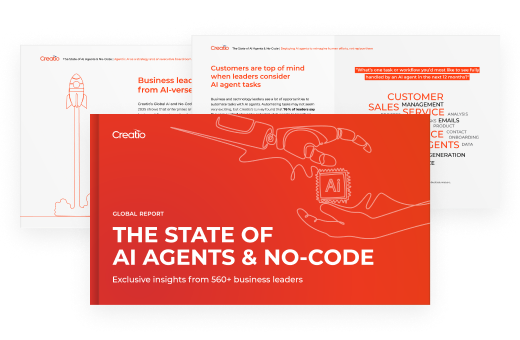-
No-Code
Platform
-
Studio
No-code agentic platform delivering the fastest time-to-value and the highest ROI
-
Studio
-
AI-Native CRM
CRM
-
AI-Native CRM
New era CRM to manage customer & operational workflows
CRM Products -
AI-Native CRM
- Industries
- Customers
- Partners
- About
AI for Cross-Selling and Upselling - How to Personalize Product Recommendations to Increase Sales
Updated on
October 23, 2024
8 min read
Increase Average Order Value With AI-Driven Insights

As modern consumers expect increasingly more personalized experiences while shopping, companies that want to stay in business must go the extra mile to meet customer needs, providing customized offers and personalized product recommendations at scale.
This is where AI cross-selling and upselling come into play, helping businesses enhance customer experience and boost their sales with accurate product recommendations tailored to individual customers' needs.
In this article, we'll explore how AI is improving cross-selling and upselling, and the benefits it brings to businesses.
AI in Cross-Selling and Upselling
AI cross-selling and upselling use machine learning algorithms to quickly analyze vast amounts of customer data to prepare personalized recommendations. Unlike the traditional non-AI approach, which is slower and often relies on one factor such as purchase history, AI-powered solutions analyze multiple variables, including browsing behavior, purchase history, products viewed, interests, similar shopping carts, etc., to provide tailored recommendations.
Thanks to AI’s capability to identify complex patterns, and continuously learn from new data, businesses can better understand their clients and suggest products and services that match their needs in real-time.
The State of AI Agents & No-Code
Learn how 560+ leaders across the world use AI and no-code to drive innovation today

Enhancing AI upselling and cross-selling
Businesses can greatly increase the efficiency of AI cross-selling and upselling solutions by integrating them with AI sales forecasting and AI lead-scoring software.
AI sales forecasting software helps businesses better understand future demand and prepare their offers in advance. Companies can also use AI lead scoring systems to identify leads most likely to react to cross-selling and upselling offers. With these insights, sales reps can focus their efforts on the most promising leads to provide tailored propositions precisely at the right moment and increase the chances of converting leads into customers.
Some solutions provide all these features in one comprehensive system, but if that’s not the case, it’s worth considering investing in these systems to gain additional benefits.
According to a survey by Adobe, personalized offers make 31% of customers feel understood, increase the trust in the brand of 24% of clients and help 37% of consumers feel less overwhelmed during online shopping.
Benefits of AI in Cross-Selling and Upselling
AI upselling and cross-selling software can bring businesses many benefits, from increased revenue to long-term customer loyalty.
Here’s the list of key cross-selling and upselling AI benefits:
- Increased revenue - AI-powered cross-selling and upselling boost business revenue by recommending relevant complementary or higher-value products that customers are likely to purchase. By encouraging larger purchases, AI helps businesses increase the average order value and improve sales performance.
- Higher Customer Lifetime Value (CLV) - AI cross-selling and upselling increase CLV by encouraging customers to purchase additional products, maximizing the total revenue a customer generates over the course of their relationship with the business.
- Improved customer experience - by using cross-selling and upselling AI software, businesses can greatly enhance the customer experience. According to an Adobe survey, over 60% of customers think that personalized offers improve their shopping experience, which highlights the value of recommendations tailored to clients’ needs.
- Enhanced customer loyalty – when a business provides relevant and accurate product suggestions, it proves to customers that it truly understands their needs, creating a sense of trust and connection. This approach strengthens customer relationships and fosters long-term loyalty.
- Reduced costs - acquiring new customers who are not yet familiar with the brand and its products is often expensive and requires large investments in marketing and sales efforts. By leveraging AI to cross-sell and upsell to current customers, businesses can reduce the costs of marketing and sales operations while boosting revenue.
Use Cases of AI Cross-Selling and Upselling
Cross-selling and upselling AI can be useful for both sales and marketing teams, helping them personalize their outreach, increase customer engagement, and drive conversions.
Sales
AI cross-selling and upselling recommendations can be automatically presented to customers (e.g. in e-commerce stores) or delivered to sales representatives who prepare tailored offers for their clients (e.g. in the finance industry).
Retail industry examples
When a customer adds several products to their basket, an AI cross-selling tool can analyze the contents of the basket, and quickly compare it with past purchases, similar shopping carts, customer behavior data, etc., to automatically recommend additional products that will complement the purchase. AI will also adapt these recommendations in real time based on new data and changes in customer behavior.
According to McKinsey, by 2023, 35% of purchases on Amazon came from product recommendations based on AI algorithms and predictive models.
In e-commerce, these recommendations are often presented in the form of “You may also like”, or “Customers who bought this item also bought” sections on the website. This way, AI can attract the customer's attention to products they have previously missed, increasing customer engagement and the company’s revenue. Similarly, an AI up-selling system can prepare highly accurate upselling offers with premium or upgraded products with advanced features.

Example of Amazon’s AI-empowered cross-selling product recommendations
To further increase the appeal of cross-selling and upselling offers, businesses can use dynamic pricing software to offer discounts, promotional bundles, and other financial incentives that will help them persuade customers to opt for additional services or upgraded products. For example, a cross-selling/upselling AI system paired with dynamic pricing can automatically reduce the price of recommended products, if customers decide to add two more items to their shopping carts.
Banking industry examples
With highly accurate recommendations based on the client’s financial behavior, sales reps have a greater chance of engaging the customer and signing a deal on additional or upgraded financial products.
Cross-selling AI for banks can analyze customer transaction history and spending patterns to recommend relevant products that could improve customers’ financial needs. For instance, if a client frequently uses a debit card during international travel, the AI software might notify sales agents that it's worth offering this client a foreign currency account or a travel rewards credit card.
Similarly, upselling AI can evaluate a customer's needs and loan repayment history to determine their eligibility and interest in higher-value financial products. For example, if a customer has a history of repaying personal loans on time, AI could suggest an upgraded loan with better terms.
Marketing
Marketing professionals can use upselling and cross-selling AI to automatically include related and upgraded products in newsletters, social media posts, ads, website pop-ups, etc.
AI can help personalize marketing materials by analyzing customer behavior and purchase history to automatically recommend complementary products. For example, marketing professionals can create an email campaign to suggest accessories for a product the customer has purchased recently. Thanks to AI cross-selling software, they can add a “related products” section without manually going through each customer's data.
AI can also enhance upselling opportunities in marketing content by analyzing customers' preferences and browsing data. Based on these recommendations, marketing professionals can create a retargeting ad campaign to promote upgraded products.
How to Implement AI Cross-Selling and Upselling
Implementing cross-selling and upselling AI requires a few steps to ensure the system delivers relevant, personalized recommendations that enhance the customer experience.
Here’s a step-by-step guide:
1. Define business goals
Begin by identifying what you want to achieve with AI cross-selling and upselling. Your goal might be to increase customer lifetime value, boost revenue without acquiring new customers, or increase average order value. Whatever it is, having specific goals will help you tailor the AI system to meet your needs and determine whether the implementation was successful.
2. Choose the right AI tool
Select an AI-powered tool or a platform that best suits your goals and budget. Choose a standalone tool or a CRM system that comes with built-in cross-selling and upselling AI features. Ensure it integrates smoothly with other tools from your technology stack, such as marketing automation, and eCommerce platforms.
3. Collect and organize customer data
Collect data from multiple sources, such as websites, mobile apps, social media, email campaigns, etc. Use a tool like a data management platform to automate the process of cleaning, organizing, and updating data for accurate AI recommendations.
4. Test and optimize
Run tests on a smaller scale before fully deploying the algorithm to measure the effectiveness of cross-selling and upselling AI. Gather customer and employee feedback and optimize the algorithm if necessary.
5. Regularly monitor the system performance
Cross-selling and upselling AI systems improve over time as more data becomes available. Regularly monitor the system’s performance by tracking key metrics such as average order value, customer satisfaction, and conversion rates. If you’re not meeting your KPIs, adjust the algorithm, and repeat this and previous step to improve the accuracy of personalized recommendations.
6. Maintain the human touch
AI can handle much of the cross-selling and upselling recommendation process. However, there are still situations and complex transactions where human input can be essential, such as addressing unique customer needs, providing detailed product explanations, or dealing with customers making high-stakes purchasing decisions.
Cross-sell and upsell AI Challenges
One of the biggest challenges that businesses using AI cross-selling and upselling software face is customers’ privacy concerns. 38% of consumers surveyed by Adobe said that personalization in an online retail shop infringed on their privacy and made them feel stalked across other websites. Furthermore, over 50% of customers from the same survey feel that advanced personalization empowered by AI technology might become a threat to their privacy in the future.
While AI-personalized recommendations can improve the shopping experience, businesses need to be more transparent about how customer data is collected and used. Clear communication about data practices helps build trust and prevents customers from feeling uncomfortable or unsafe. Offering control over privacy settings can make customers more confident in sharing their data.
Another challenge is dealing with poor quality or insufficient data. AI algorithms need high-quality data to make accurate cross-selling and upselling recommendations. Otherwise, suggestions might be flawed or incomplete, making customers feel frustrated and misunderstood. To make sure the AI algorithm has access to reliable data, businesses must introduce robust data management practices mentioned in the 3rd step of the implementation guide.
Boosting Sales Performance with Upselling and Cross-selling AI
AI cross-selling and upselling help businesses improve customer satisfaction and increase revenue. The key to success is choosing the right tool. Creatio Sales stands out as the best solution thanks to its robust CRM equipped with an AI Next Best Offer feature empowered by AI lead scoring, and AI sales forecasting.
Creatio’s Next Best Offer empowered by AI virtual assistant Copilot
The Next Best Offer (NBO) feature analyzes customer data to identify the products or services a customer is most likely to be interested in, allowing businesses to make highly targeted, relevant offers. With Creatio Sales, businesses can not only enhance their cross-selling and upselling efforts but also build stronger, more meaningful relationships with their customers.
Transform your sales approach with Creatio’s AI-driven insights for effective cross-selling and upselling






















































